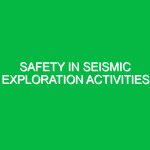In the realm of oil and gas exploration, the importance of Well Control and Blowout Prevention cannot be overstated. These concepts play a pivotal role in ensuring the safety of personnel, the environment, and the integrity of operations. Well Control refers to the methods and techniques used to manage the pressure in a well to prevent uncontrolled flow of fluids, while Blowout Prevention encompasses the systems and practices that safeguard against blowouts, which are uncontrolled releases of oil, gas, or other fluids from a well. In this article, we will delve into the intricacies of these critical processes, highlighting their relevance in the Health, Safety, and Environment (HSE) domain.
The Significance of Well Control and Blowout Prevention in HSE
Well Control and Blowout Prevention are foundational to HSE practices in the oil and gas industry. The repercussions of a blowout can be catastrophic, resulting in loss of life, environmental devastation, and significant financial loss. Historical incidents, such as the Deepwater Horizon disaster in 2010, serve as harrowing reminders of the potential consequences of inadequate well control measures. The need for stringent well control protocols is not just a regulatory requirement; it is a moral obligation to protect workers and the environment. Effective well control measures ensure that pressure is carefully monitored and managed throughout the drilling process, significantly reducing the risk of blowouts.
Identifying Hazards and Risks Associated with Well Control and Blowout Prevention
Understanding the hazards related to Well Control and Blowout Prevention is the first step in mitigating risks. Several potential hazards exist, each presenting unique challenges. Below, we outline some of the most significant hazards:
1. Formation Fluid Influx
One of the primary risks in drilling operations is the influx of formation fluids into the wellbore. This can occur when the pressure exerted by the drilling mud is insufficient to counteract the pressure from the surrounding formation. The result can be a blowout, leading to catastrophic consequences. It is essential to monitor formation pressures closely and maintain appropriate mud weights to mitigate this risk.
2. Equipment Failure
Failures in blowout preventers (BOPs) or other critical equipment can lead to uncontrolled well flow. Routine maintenance and testing of BOPs are imperative to ensure their functionality. For instance, during a drilling operation in the North Sea, a malfunctioning BOP led to a near-miss incident, prompting a thorough review of equipment protocols across the fleet. Such experiences highlight the importance of rigorous equipment management.
3. Human Error
Despite the technological advancements in drilling operations, human error remains a significant factor in well control incidents. Miscommunication, inadequate training, or failure to follow protocols can lead to dangerous situations. For example, a drilling crew on an offshore rig once miscalculated the mud weight required to maintain pressure, resulting in a near blowout. Continuous education and simulation training can help reduce the likelihood of such errors.
4. Environmental Conditions
Adverse weather conditions, such as high winds and rough seas, can complicate drilling operations. These factors can affect the stability of the rig and the ability to perform effective well control. It is vital to have contingency plans in place to address such environmental challenges.
Best Practices and Safety Precautions for Well Control and Blowout Prevention
To effectively safeguard against the hazards outlined above, implementing best practices and safety precautions is crucial. The following strategies can enhance well control and blowout prevention efforts:
1. Rigorous Training Programs
Ensuring that personnel are well-trained in well control procedures is fundamental. Regular training sessions, including simulation drills, can prepare the crew to respond effectively in emergency situations. For instance, during a training exercise, a crew member successfully executed a blowout scenario simulation, demonstrating the importance of preparedness in real-life situations.
2. Regular Equipment Inspections
Scheduled inspections and maintenance of BOPs and other critical equipment should be a non-negotiable aspect of operations. Implementing a robust maintenance program can identify potential issues before they escalate into serious problems. A notable incident involved a rig where the BOP had not been inspected adequately, leading to a failure during a critical moment. This emphasizes the importance of proactive equipment management.
3. Real-time Monitoring Systems
Utilizing real-time monitoring systems can provide valuable data on well conditions, allowing for immediate adjustments to be made in response to changing pressures. Investing in advanced monitoring technology can significantly enhance the ability to maintain well control.
4. Establishing Clear Communication Protocols
Effective communication is vital in ensuring that all team members are aware of their roles and responsibilities. Regular briefings and updates can help maintain situational awareness, particularly during critical operations. For example, during a drilling campaign in the Gulf of Mexico, enhanced communication protocols led to improved coordination among crew members and a reduction in incidents.
5. Emergency Response Preparedness
Having an emergency response plan in place is essential. This plan should define roles, responsibilities, and procedures to follow in the event of a blowout. Conducting regular drills can help ensure that everyone knows what to do if an emergency arises, reducing response times and potentially saving lives.
Regulations and Standards Governing Well Control and Blowout Prevention
Compliance with regulations and industry standards is critical in maintaining effective Well Control and Blowout Prevention practices. Several key regulations govern these processes:
1. API Standards
The American Petroleum Institute (API) has established several standards related to well control, including API Standard 53, which outlines the requirements for blowout prevention equipment. Adhering to these standards helps ensure that operations meet industry best practices.
2. OSHA Regulations
The Occupational Safety and Health Administration (OSHA) enforces regulations that apply to oil and gas operations, including requirements related to safety training and emergency response. Compliance with OSHA standards is mandatory for all operators.
3. Local and National Regulations
In addition to API and OSHA standards, operators must also comply with local and national regulations that govern drilling activities. These regulations can vary by region, making it essential for companies to be aware of the specific requirements in their operational areas. For example, the UK’s Health and Safety Executive (HSE) has implemented strict regulations governing offshore drilling to enhance safety and environmental protection.
Conclusion: The Path Forward in Well Control and Blowout Prevention
As the oil and gas industry continues to evolve, the importance of Well Control and Blowout Prevention remains paramount. By understanding the potential hazards, implementing best practices, and adhering to regulations, operators can significantly mitigate risks. The lessons learned from past incidents should serve as a guide for continuous improvement in safety practices. Ultimately, the commitment to well control and blowout prevention not only protects the workforce and environment but also fortifies the integrity of the industry as a whole. In an ever-changing landscape, prioritizing safety is not just good practice; it is the foundation upon which the future of oil and gas operations must be built.


